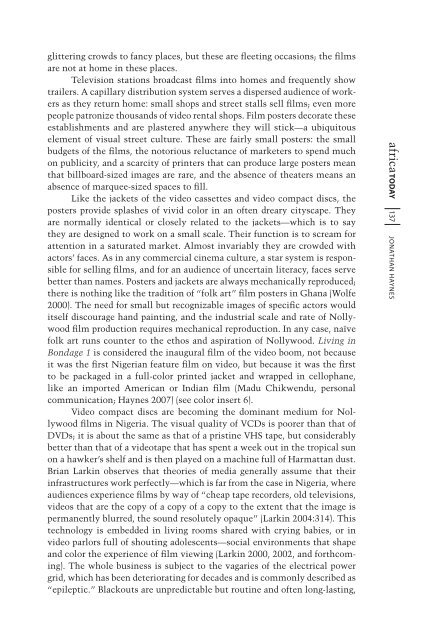Lagos is the ground of the films, not just in the sense that ... - myweb
Lagos is the ground of the films, not just in the sense that ... - myweb
Lagos is the ground of the films, not just in the sense that ... - myweb
Create successful ePaper yourself
Turn your PDF publications into a flip-book with our unique Google optimized e-Paper software.
glitter<strong>in</strong>g crowds to fancy places, but <strong>the</strong>se are fleet<strong>in</strong>g occasions; <strong>the</strong> <strong>films</strong>are <strong>not</strong> at home <strong>in</strong> <strong>the</strong>se places.Telev<strong>is</strong>ion stations broadcast <strong>films</strong> <strong>in</strong>to homes and frequently showtrailers. A capillary d<strong>is</strong>tribution system serves a d<strong>is</strong>persed audience <strong>of</strong> workersas <strong>the</strong>y return home: small shops and street stalls sell <strong>films</strong>; even morepeople patronize thousands <strong>of</strong> video rental shops. Film posters decorate <strong>the</strong>seestabl<strong>is</strong>hments and are plastered anywhere <strong>the</strong>y will stick—a ubiquitouselement <strong>of</strong> v<strong>is</strong>ual street culture. These are fairly small posters: <strong>the</strong> smallbudgets <strong>of</strong> <strong>the</strong> <strong>films</strong>, <strong>the</strong> <strong>not</strong>orious reluctance <strong>of</strong> marketers to spend muchon publicity, and a scarcity <strong>of</strong> pr<strong>in</strong>ters <strong>that</strong> can produce large posters mean<strong>that</strong> billboard-sized images are rare, and <strong>the</strong> absence <strong>of</strong> <strong>the</strong>aters means anabsence <strong>of</strong> marquee-sized spaces to fill.Like <strong>the</strong> jackets <strong>of</strong> <strong>the</strong> video cassettes and video compact d<strong>is</strong>cs, <strong>the</strong>posters provide splashes <strong>of</strong> vivid color <strong>in</strong> an <strong>of</strong>ten dreary cityscape. Theyare normally identical or closely related to <strong>the</strong> jackets—which <strong>is</strong> to say<strong>the</strong>y are designed to work on a small scale. Their function <strong>is</strong> to scream forattention <strong>in</strong> a saturated market. Almost <strong>in</strong>variably <strong>the</strong>y are crowded withactors’ faces. As <strong>in</strong> any commercial c<strong>in</strong>ema culture, a star system <strong>is</strong> responsiblefor sell<strong>in</strong>g <strong>films</strong>, and for an audience <strong>of</strong> uncerta<strong>in</strong> literacy, faces servebetter than names. Posters and jackets are always mechanically reproduced;<strong>the</strong>re <strong>is</strong> <strong>not</strong>h<strong>in</strong>g like <strong>the</strong> tradition <strong>of</strong> “folk art” film posters <strong>in</strong> Ghana (Wolfe2000). The need for small but recognizable images <strong>of</strong> specific actors woulditself d<strong>is</strong>courage hand pa<strong>in</strong>t<strong>in</strong>g, and <strong>the</strong> <strong>in</strong>dustrial scale and rate <strong>of</strong> Nollywoodfilm production requires mechanical reproduction. In any case, naïvefolk art runs counter to <strong>the</strong> ethos and aspiration <strong>of</strong> Nollywood. Liv<strong>in</strong>g <strong>in</strong>Bondage 1 <strong>is</strong> considered <strong>the</strong> <strong>in</strong>augural film <strong>of</strong> <strong>the</strong> video boom, <strong>not</strong> becauseit was <strong>the</strong> first Nigerian feature film on video, but because it was <strong>the</strong> firstto be packaged <strong>in</strong> a full-color pr<strong>in</strong>ted jacket and wrapped <strong>in</strong> cellophane,like an imported American or Indian film (Madu Chikwendu, personalcommunication; Haynes 2007) (see color <strong>in</strong>sert 6).Video compact d<strong>is</strong>cs are becom<strong>in</strong>g <strong>the</strong> dom<strong>in</strong>ant medium for Nollywood<strong>films</strong> <strong>in</strong> Nigeria. The v<strong>is</strong>ual quality <strong>of</strong> VCDs <strong>is</strong> poorer than <strong>that</strong> <strong>of</strong>DVDs; it <strong>is</strong> about <strong>the</strong> same as <strong>that</strong> <strong>of</strong> a pr<strong>is</strong>t<strong>in</strong>e VHS tape, but considerablybetter than <strong>that</strong> <strong>of</strong> a videotape <strong>that</strong> has spent a week out <strong>in</strong> <strong>the</strong> tropical sunon a hawker’s shelf and <strong>is</strong> <strong>the</strong>n played on a mach<strong>in</strong>e full <strong>of</strong> Harmattan dust.Brian Lark<strong>in</strong> observes <strong>that</strong> <strong>the</strong>ories <strong>of</strong> media generally assume <strong>that</strong> <strong>the</strong>ir<strong>in</strong>frastructures work perfectly—which <strong>is</strong> far from <strong>the</strong> case <strong>in</strong> Nigeria, whereaudiences experience <strong>films</strong> by way <strong>of</strong> “cheap tape recorders, old telev<strong>is</strong>ions,videos <strong>that</strong> are <strong>the</strong> copy <strong>of</strong> a copy <strong>of</strong> a copy to <strong>the</strong> extent <strong>that</strong> <strong>the</strong> image <strong>is</strong>permanently blurred, <strong>the</strong> sound resolutely opaque” (Lark<strong>in</strong> 2004:314). Th<strong>is</strong>technology <strong>is</strong> embedded <strong>in</strong> liv<strong>in</strong>g rooms shared with cry<strong>in</strong>g babies, or <strong>in</strong>video parlors full <strong>of</strong> shout<strong>in</strong>g adolescents—social environments <strong>that</strong> shapeand color <strong>the</strong> experience <strong>of</strong> film view<strong>in</strong>g (Lark<strong>in</strong> 2000, 2002, and forthcom<strong>in</strong>g).The whole bus<strong>in</strong>ess <strong>is</strong> subject to <strong>the</strong> vagaries <strong>of</strong> <strong>the</strong> electrical powergrid, which has been deteriorat<strong>in</strong>g for decades and <strong>is</strong> commonly described as“epileptic.” Blackouts are unpredictable but rout<strong>in</strong>e and <strong>of</strong>ten long-last<strong>in</strong>g,africa today 137 Jonathan Haynes
















